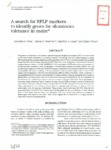Use este identificador para citar ou linkar para este item:
http://www.alice.cnptia.embrapa.br/alice/handle/doc/478779Registro completo de metadados
| Campo DC | Valor | Idioma |
|---|---|---|
| dc.contributor.author | TORRES, G. A. | pt_BR |
| dc.contributor.author | PARENTONI, S. N. | pt_BR |
| dc.contributor.author | LOPES, M. A. | pt_BR |
| dc.contributor.author | PAIVA, E. | pt_BR |
| dc.date.accessioned | 2011-04-10T11:11:11Z | pt_BR |
| dc.date.available | 2011-04-10T11:11:11Z | pt_BR |
| dc.date.created | 1998-01-29 | pt_BR |
| dc.date.issued | 1997 | pt_BR |
| dc.identifier.citation | Revista Brasileira de Genética, Ribeirão Preto, v. 20, n. 3, p. 459-465, 1997. | pt_BR |
| dc.identifier.uri | http://www.alice.cnptia.embrapa.br/alice/handle/doc/478779 | pt_BR |
| dc.description | The objective of this study was to identify restriction fragment length polymorphism (RFLP) markers linked to QTLs that control aluminum (Al) tolerance in maize. The strategy used was bulked segregation analysis (BSA) and the genetic material utilized was an F2 population derived from a cross between the Al-susceptible inbred line L53 and Al-tolerant inbred line L1327. Both lines were developed at the National Maize and Sorghum Research Center - CNPMS/EMBRAPA. The F2 population of 1554 individuals was evaluated in a nutrient solution containing a toxic concentration of Al and relative seminal root length (RSRL) was used as a phenotype measured tolerance. The RSRL frequency distribution was continuous, but skewed towards Al-susceptible individuals. Seedlings of the F2 population which scored the highest and the lowest RSRL values were transplanted to the field and subsequently selfed to obtain F3 families. Thirty F3 families (15 Al-susceptible and 15 Al-tolerant) were evaluated in nutrient solution, using an incomplete block design, to identify those with the smallest variances for aluminum tolerance and susceptibility. Six Al-susceptible and five Al-tolerant F3 families were chosen to construct one pool of Al-susceptible individuals, and another of Al-tolerant, herein refered as "bulks", based on average values of RSRL and genetic variance. One hundred and thirteen probes were selected, with an average interval of 30 cM, covering the 10 maize chromosomes. These were tested for their ability to discriminate the parental lines. Fifty-four of these probes were polymorphic, with 46 showing codominance. These probes were hybridized with DNA from the two contrasting bulks. Three RFLPs on chromosome 8 distinguished the bulks on the basis of band intensity. DNA of individuals from the bulks was hybridized with these probes and showed the presence of heterozygous individuals in each bulk. These results suggest that in maize there is a region related to aliminum tolerance on chromosome 8. | pt_BR |
| dc.language.iso | eng | eng |
| dc.rights | openAccess | eng |
| dc.subject | Tolerancia | pt_BR |
| dc.subject | Maize | pt_BR |
| dc.subject | RFLP | pt_BR |
| dc.subject | Tolerance | pt_BR |
| dc.title | A search for RFLP markers to identify genes for aluminum tolerance in maize. | pt_BR |
| dc.type | Artigo de periódico | pt_BR |
| dc.date.updated | 2018-06-12T11:11:11Z | pt_BR |
| dc.subject.thesagro | Alumínio | pt_BR |
| dc.subject.thesagro | Milho | pt_BR |
| dc.subject.thesagro | Zea Mays | pt_BR |
| dc.subject.nalthesaurus | aluminum | pt_BR |
| riaa.ainfo.id | 478779 | pt_BR |
| riaa.ainfo.lastupdate | 2018-06-12 -03:00:00 | pt_BR |
| dc.contributor.institution | EMBRAPA/CNPMS; SIDNEY NETTO PARENTONI, CNPMS. | pt_BR |
| Aparece nas coleções: | Artigo em periódico indexado (CNPMS)  | |
Arquivos associados a este item:
| Arquivo | Descrição | Tamanho | Formato | |
|---|---|---|---|---|
| SearchRFLP.pdf | 6,94 MB | Adobe PDF |  Visualizar/Abrir |









